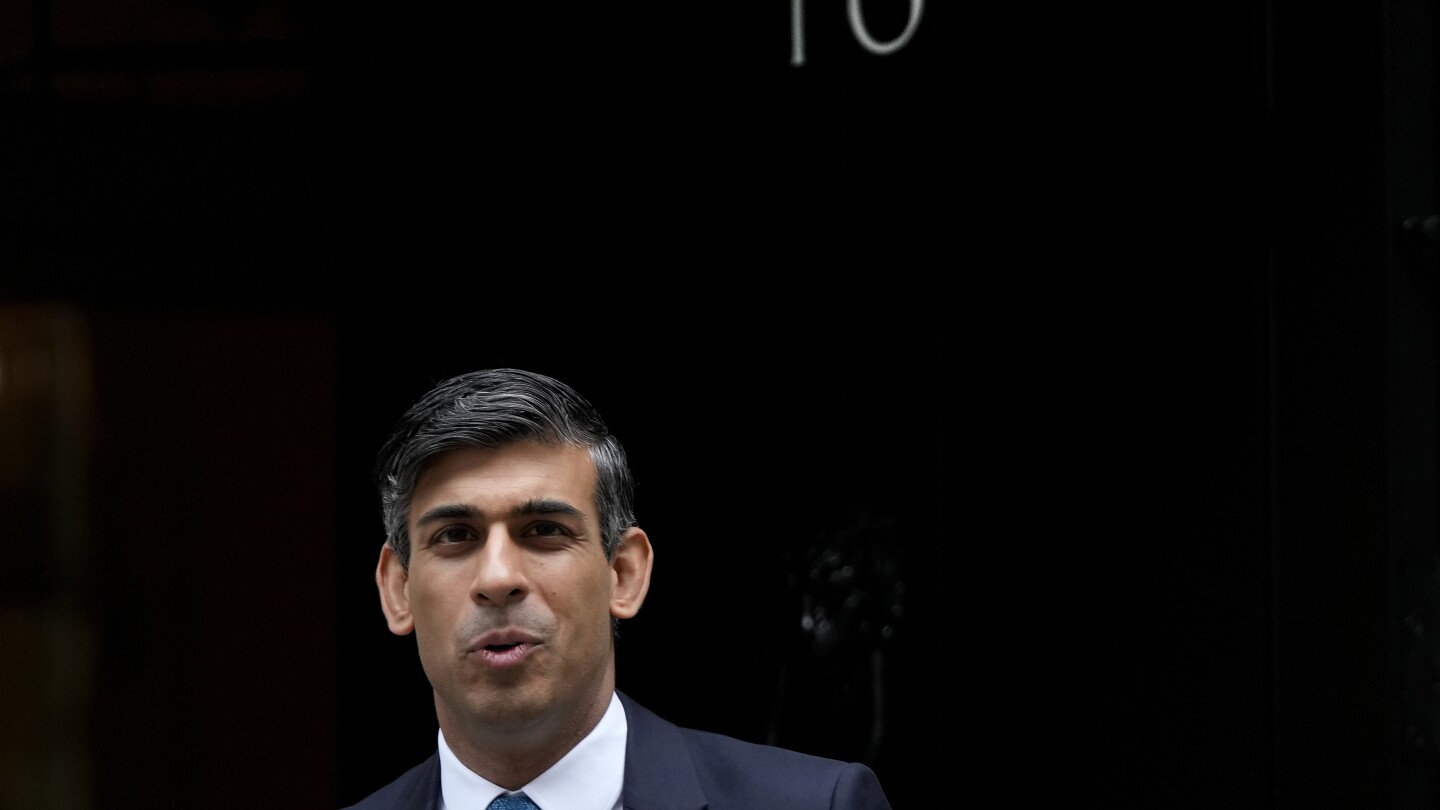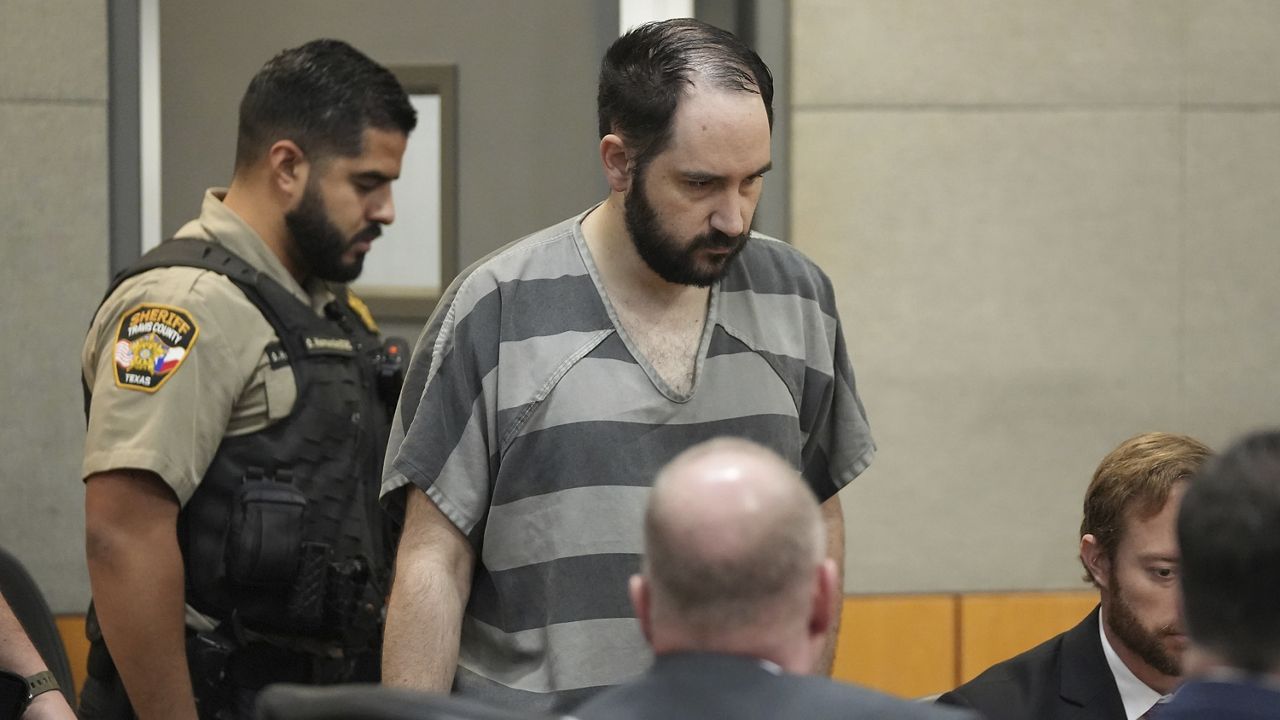World
Summer’s over for UK politicians as Sunak faces a crisis over crumbling schools

LONDON (AP) — British lawmakers headed back to Parliament on Monday after their summer break. But thousands of U.K. children won’t be returning to their classrooms this week, because their schools are at risk of collapse from crumbling concrete.
The news is a start-of-term headache for Prime Minister Rishi Sunak as he scrambles to shore up flagging support for the governing Conservative Party ahead of a national election next year.
Sunak insists it’s not his fault that more than 100 schools were told last week — days before the start of the new school year — to shut some or all of their buildings because they contain a type of lightweight, air-filled concrete widely used in construction between the 1950s and the 1990s.
School leaders are scrambling to find classroom space in nearby establishments or resorting to online instruction after the government’s last-minute directive, sparked when three schools thought to be safe suffered collapses over the summer.
The government says the “vast majority” of schools are not affected by problems with reinforced autoclaved aerated concrete. The material, known as RAAC, is lighter and less expensive than standard reinforced concrete — but also weaker, with a useful life of about 30 years.
The government says the total number of affected schools is likely to be in the hundreds but not the thousands.
“I know the timing is frustrating, but I want to give people a sense of the scale of what we are grappling with here,” Sunak told broadcasters. “There are around 22,000 schools in England and the important thing to know is that we expect that 95% of those schools won’t be impacted by this.”
To the opposition, crumbling schools are a metaphor for the state of a country they claim has become “Broken Britain” due to public-sector cost-cutting during 13 years of Conservative rule.
The sense of crisis grew when Education Secretary Gillian Keegan was overheard seeming to gripe about facing criticism for the concrete problems.
While still connected to a microphone after an interview with British TV network ITV, she said: “Does anyone ever say, you know what, you’ve done a … good job because everyone else has sat on their (bottom) and done nothing?” She used a strong expletive before “good.”
The clip was viewed millions of times on social media within an hour. Keegan later apologized for her “choice language” but said she felt frustrated because “the interviewer was making out it was all my fault.”
Critics said the government should accept some blame. A former senior civil servant in the education department, Jonathan Slater, said Monday that Sunak, while serving as Britain’s Treasury chief in 2021, had halved the number of schools to be refurbished each year from 100 to 50 – far fewer than the 300 to 400 Slater said were needed.
Sunak said that allegation was “completely and utterly wrong.” He said refurbishing about 50 schools a year was in line with what past governments had done.
The use of RAAC was not limited to schools. Courts, hospitals and other public buildings were also built using aerated concrete, often for roofs.
Labour Party education spokeswoman Bridget Phillipson said the government was “still not being upfront about the scale of what we are facing” and “ministers need to get a grip on this.”
The school crisis brings more unwanted drama for Sunak, who took office 11 months ago with a promise to restore steady government after his predecessor, Liz Truss, rocked the economy with a plan for big, unfunded tax cuts.
Sunak is already struggling to meet his five key pledges, which include halving inflation from its 11% high by the end of the year — it was 6.8% in July — and cutting the number of migrants reaching the U.K. across the English Channel in small boats. Opinion polls put the Conservatives as much as 20 points behind the Labour opposition, with an election due to be held by the end of 2024.
Despite the poll lead, Labour leader Keir Starmer faces criticism that his dull, lawyerly approach to politics is failing to excite the electorate.
Starmer took over in 2020 from left-winger Jeremy Corbyn, who led Labour to two election defeats. Starmer has tried to nudge the party back toward the political center ground it occupied under former Prime Minister Tony Blair. Blair is Labour’s most successful leader, winning three successive elections starting in 1997, but remains a controversial figure in the party, vilified by some for watering down Labour’s socialist values and joining the U.S.-led 2003 invasion of Iraq.
Starmer tried to strengthen his hand by shaking up his top team Monday in a bid to create a government-in-waiting to fight the next election.
He promoted several lawmakers from the right of the party, including Liz Kendall, Peter Kyle and Pat McFadden. There was a promotion for deputy leader Angela Rayner, who adds responsibility for “leveling up” — addressing Britain’s huge economic and social inequalities — to her deputy role. A sometime Corbyn ally popular with the party grassroots, Rayner is seen as a valuable contrast in style and tone to Starmer.
“I’m really pleased that, having changed the Labour Party, we are now in position to put our top team on the table, to show it to the country,” Starmer said. “I’m delighted that we’ve got such a strong team on the pitch now.”

World
Ukraine's divisive mobilization law comes into force as a new Russian push strains front-line troops
KYIV, Ukraine (AP) — A divisive mobilization law in Ukraine came into force on Saturday, as Kyiv struggles to boost troop numbers after Russia launched a new offensive that some fear could close in on Ukraine’s second-largest city.
The legislation, which was watered down from its original draft, will make it easier to identify every conscript in the country. It also provides incentives to soldiers, such as cash bonuses or money toward buying a house or car, that some analysts say Ukraine cannot afford.
Lawmakers dragged their feet for months and only passed the law in mid-April, a week after Ukraine lowered the age for men who can be drafted from 27 to 25. The measures reflect the growing strain that more than two years of war with Russia has had on Ukraine’s forces, who are trying to hold the front lines in fighting that has sapped the country’s ranks and stores of weapons and ammunition.
Ukrainian President Volodymyr Zelenskyy also signed two other laws Friday, allowing prisoners to join the army and increasing fines for draft dodgers fivefold. Russia enlisted its prisoners early on in the war, and personnel shortages compelled Ukraine to adopt the new measures.
Russian troops, meanwhile, are pushing ahead with a ground offensive that opened a new front in northeastern Ukraine’s Kharkiv region and put further pressure on Kyiv’s overstretched military. After weeks of probing, Moscow launched the new push knowing that Ukraine suffered personnel shortages, and that its forces have been spread thin in the northeast.
Russian President Vladimir Putin said on Friday during a visit to China that the Russian push aims to create “a buffer zone” rather than capturing Kharkiv, the local capital and Ukraine’s second-largest city.
Still, Moscow’s forces have pummeled Kharkiv with strikes in recent weeks, hitting civilian and energy infrastructure and prompting angry accusations from Zelenskyy that the Russian leadership sought to reduce the city to rubble. On Friday, Mayor Ihor Terekhov said that Russian guided bombs killed at least three residents and injured 28 others that day.
Moscow denies deliberately targeting civilians, but thousands have died or suffered injuries in the more than 27 months of fighting.
The U.S. last week announced a new $400 million package of military aid for Ukraine, and President Joe Biden has promised that he would rush badly needed weaponry to the country to help it stave off Russian advances. Still, only small batches of U.S. military aid have started to trickle into the front line, according to Ukrainian military commanders, who said it will take at least two months before supplies meet Kyiv’s needs to hold the line.
Thousands of Ukrainians have fled the country to avoid the draft since Russia’s all-out invasion in February 2022, some risking their lives as they tried to swim across a river separating Ukraine from neighboring Romania and Hungary.
Late on Friday, Ukraine’s border service said that at least 30 people have died trying to cross the Tisza River since the full scale-invasion.
Romanian border guards days earlier retrieved the near-naked, disfigured body of a man that appeared to have been floating in the Tisza for days, and is the 30th known casualty, the Ukrainian agency said in an online statement. It said the man has not yet been identified.
___
Follow AP’s coverage at https://apnews.com/hub/russia-ukraine
World
An unusual autumn freeze grips parts of South America, giving Chile its coldest May in 74 years

Chileans are bundling up for their coldest autumn in more than 70 years mere days after sunning in T-shirts — a dramatic change of wardrobe brought on this week by a sudden cold front gripping portions of South America unaccustomed to bitter wind chills this time of year.
CHILE SHUTS DOWN A POPULAR GLACIER, SPARKING DEBATE OVER CLIMATE CHANGE AND ADVENTURE SPORTS
Temperatures broke records along the coast of Chile and in Santiago, the capital, dipping near freezing and making this month the coldest May that the country has seen since 1950, the Chilean meteorological agency reported.
An unusual succession of polar air masses has moved over southern swaths of the continent, meteorological experts say, pushing the mercury below zero Celsius (32 Fahrenheit) in some places. It’s the latest example of extreme weather in the region — a heat wave now baking Mexico, for instance — which scientists link to climate change.
Footprints create the shape of a heart in a snow-covered rugby field in Santiago, Chile, Wednesday, May 8, 2024. (AP Photo/Matias Basualdo)
“The past few days have been one of the longest (cold fronts) ever recorded and one of the earliest ever recorded” before the onset of winter in the Southern Hemisphere, said Raul Cordero, a climatologist at Santiago University. “Typically the incursions of cold air from the Antarctic that drive temperatures below zero occur from June onwards, not so much in May.”
The cold front sweeping in from Antartica has collided with warm air pushing in from the northwestern Amazon, helping fuel heavy rainstorms battering Brazil, according to that country’s National Meteorological system.
Chile’s government issued frosty weather alerts for most of the country and ramped up assistance for homeless people struggling to endure the frigid temperatures on the streets. Snow cloaked the peaks of the Andes and fell in parts of Santiago, leading to power outages in many areas this week.
“Winter came early,” said Mercedes Aguayo, a street vendor hawking gloves and hats in Santiago.
She said she was glad for a boost in business after Chile’s record winter heat wave last year, which experts pinned on climate change as well as the cyclical El Niño weather pattern.
“We had stored these goods (hats and gloves) for four years because winters were always more sporadic, one day hot, one day cold,” Aguayo said.
This week’s cold snap also took parts of Argentina and Paraguay by surprise.
Energy demand soared across many parts of Argentina. Distributors cut supplies to dozens of gas stations and industries in several provinces to avoid outages in households, , the country’s main hydrocarbon company, CECHA, said Thursday.
World
Brussels, my love? Transparency over MEPs' side jobs

In this edition, we look at what lawmakers’ extracurricular activities mean for their core role.
This week, we are joined by Sophia Russack, senior researcher from the Centre for European Policy Studies, Petros Fassoulas, secretary general of European Movement International and Anna Nalyvayko, senior project officer from the Wilfried Martens Center.
Panelists debate the ethical questions raised by MEPs who have side jobs. Those extra roles are legal, but the political earthquake caused by the Qatarargate scandal led to tighter rules and more transparency.
Is this enough to bridge the gulf between citizens and politicians, in today’s fractured political landscape?
“We see that they have improved rules when it comes to reporting requirements, to laying open your financial situation before and after the offers, and so on. But to be honest, none of these things will prevent another Qatargate,” said Sophia Russack, a think tanker who is an expert in EU institutional architecture, decision-making processes and institutional reform.
Despite these concerns, Petros Fassoulas said MEPs shouldn’t abandon contact with the real world altogether.
“It’s important for them to have the opportunity to bring expertise from outside and engage also with the world outside of the chamber,” Fassoulas said. “An MEP or any parliamentarian should be in contact with the people that they regulate, the businesses that they have an impact on.”
Guests also discussed the reasons for the crisis of public confidence in politicians, and gave some ideas for solutions.
Watch “Brussels, my love?” in the player above.
-

 World1 week ago
World1 week agoPentagon chief confirms US pause on weapons shipment to Israel
-

 Politics1 week ago
Politics1 week agoRFK Jr said a worm ate part of his brain and died in his head
-

 Politics1 week ago
Politics1 week agoOhio AG defends letter warning 'woke' masked anti-Israel protesters they face prison time: 'We have a society'
-

 News1 week ago
News1 week agoNine Things We Learned From TikTok’s Lawsuit Against The US Government
-

 Politics1 week ago
Politics1 week agoBiden’s decision to pull Israel weapons shipment kept quiet until after Holocaust remembrance address: report
-

 Education1 week ago
Education1 week agoVideo: Police Use Pepper Spray on Protesters on G.W.U.’s Campus
-

 World1 week ago
World1 week agoA look at Chinese investment within Hungary
-

 News1 week ago
News1 week agoThe Major Supreme Court Cases of 2024















